Mostrar el registro sencillo del ítem
dc.contributor.author
Pedrazzini, S.
dc.contributor.author
Galano, M.
dc.contributor.author
Audebert, Fernando Enrique

dc.contributor.author
Smith, G. D. W.
dc.date.available
2019-09-10T18:38:08Z
dc.date.issued
2017-09
dc.identifier.citation
Pedrazzini, S.; Galano, M.; Audebert, Fernando Enrique; Smith, G. D. W.; Elevated temperature mechanical behaviour of nanoquasicrystalline Al93Fe3Cr2Ti2 alloy and composites; Elsevier Science Sa; Materials Science and Engineering A: Structural Materials: Properties, Microstructure and Processing; 705; 9-2017; 352-359
dc.identifier.issn
0921-5093
dc.identifier.uri
http://hdl.handle.net/11336/83274
dc.description.abstract
Rapidly solidified nano-quasicrystalline Al93Fe3Cr2Ti2 at% alloy has previously shown outstanding tensile and compressive strength and microstructural stability up to elevated temperatures. Despite this, no study had previously assessed the effect of plastic deformation at elevated temperature to simulate thermal-mechanical forging processes for the production of engineering components. The present work analysed bars consisting of a nano-quasicrystalline Al93Fe3Cr2Ti2 at% alloy matrix, with the addition of 10 and 20 vol% pure Al ductilising fibres, produced through gas atomisation and warm extrusion. The microstructure was made primarily of nanometre-sized icosahedral particles in an α-Al matrix. Compression tests were performed across a range of temperatures and strain rates. The measured yield strength at 350 °C was over 3x that of “high strength” 7075 T6 Al alloy, showing outstanding thermal stability and mechanical performance. However, the microstructure was shown by XRD to undergo a phase transformation which resulted in the decomposition of the icosahedral phase around ~500 °C into more stable intermetallic phases. Serrated flow associated with dynamic strain ageing was observed and a semi-quantitative analysis matching elemental diffusion speeds with dislocation speed at specific strain rates was performed, which tentatively identified Ti as the solute species responsible within the selected range of temperatures and strain rates.
dc.format
application/pdf
dc.language.iso
eng
dc.publisher
Elsevier Science Sa

dc.rights
info:eu-repo/semantics/openAccess
dc.rights.uri
https://creativecommons.org/licenses/by-nc-nd/2.5/ar/
dc.subject
Aluminium
dc.subject
Dynamic Strain Ageing
dc.subject
Fibre Composite
dc.subject
Mechanical Properties
dc.subject
Quasicrystals
dc.subject.classification
Ingeniería de los Materiales

dc.subject.classification
Ingeniería de los Materiales

dc.subject.classification
INGENIERÍAS Y TECNOLOGÍAS

dc.title
Elevated temperature mechanical behaviour of nanoquasicrystalline Al93Fe3Cr2Ti2 alloy and composites
dc.type
info:eu-repo/semantics/article
dc.type
info:ar-repo/semantics/artículo
dc.type
info:eu-repo/semantics/publishedVersion
dc.date.updated
2019-08-30T14:18:19Z
dc.journal.volume
705
dc.journal.pagination
352-359
dc.journal.pais
Países Bajos

dc.journal.ciudad
Amsterdam
dc.description.fil
Fil: Pedrazzini, S.. University of Oxford; Reino Unido. University of Cambridge; Reino Unido
dc.description.fil
Fil: Galano, M.. University of Oxford; Reino Unido
dc.description.fil
Fil: Audebert, Fernando Enrique. University of Oxford; Reino Unido. Consejo Nacional de Investigaciones Científicas y Técnicas. Oficina de Coordinación Administrativa Houssay. Instituto de Tecnologías y Ciencias de la Ingeniería "Hilario Fernández Long". Universidad de Buenos Aires. Facultad de Ingeniería. Instituto de Tecnologías y Ciencias de la Ingeniería "Hilario Fernández Long"; Argentina
dc.description.fil
Fil: Smith, G. D. W.. University of Oxford; Reino Unido
dc.journal.title
Materials Science and Engineering A: Structural Materials: Properties, Microstructure and Processing

dc.relation.alternativeid
info:eu-repo/semantics/altIdentifier/doi/http://dx.doi.org/10.1016/j.msea.2017.08.075
dc.relation.alternativeid
info:eu-repo/semantics/altIdentifier/url/https://www.sciencedirect.com/science/article/pii/S0921509317310912
Archivos asociados
